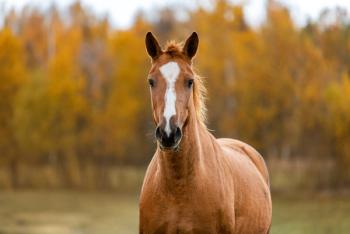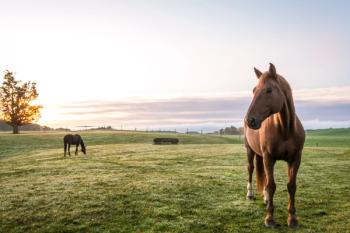
Calif. researchers collaborate on animal, human health
Veterinarians, physicians and PhDs are forming at the University of California-Davis to conduct basic research, develop clinical applications and conduct clinical trials in regenerative medicine that will yield great benefits in animal and human health.
Veterinarians, physicians and PhDs at the University of California-Davis are forming a coalition to conduct basic research, develop clinical applications and conduct clinical trials in regenerative medicine that will yield great benefits in animal and human health.
A collaborative future: Stem cell therapy is the current focus of the union of three departments-the veterinary school, medical school and engineering college- at the University of California-Davis.
The UC Davis Regenerative Medicine Consortium, which is combining expertise from the veterinary school, medical school and engineering college (biomedical engineering department), constitutes a unique and synergistic scientific opportunity to develop new biological-medical therapies.
"Our veterinary investigative team has been an ongoing enterprise for over four years, and our production of new knowledge has been remarkable," says Gregory Ferraro, DVM, director of the Center for Equine Health. "Our new five-story building dedicated to translational research houses our regenerative medicine group and provides a superior opportunity for scientific collaboration between investigators with a broad array of divergent skills. Within our teaching hospital, we have a clinical regenerative medicine laboratory where we grow and expand stem cells for use by veterinary clinicians in the treatment of animal patients."
The veterinary school regenerative medicine research group had established an early working relationship with Jan Nolta, PhD, director of the Institute for Regenerative Cures at the UC Davis Health Sciences campus. Nolta's research team of 150 scientists is housed in a newly renovated 100,000-square-foot building in Sacramento, Calif., about 20 miles from the Davis campus.
"We collaborate closely with the Institute for Regenerative Cures and currently have several graduate students and post-doctoral researchers who work with both groups," says Ferraro. "They provide one element in a significant collaborative link between our human and veterinary regenerative medicine research teams."
Work on biological scaffold, matrix
Veterinary school officials are also working with the College of Engineering's Department of Biomedical Engineering (BME), headed by Kyriacos A. Athanasiou, PhD. According to Athanasiou, the BME department straddles human medicine, veterinary medicine, life sciences and the business school, and, like glue, holds together the regenerative medicine programs run by the other disciplines. Their work is focused on biological scaffold and matrix development that, when combined with stem cells, can aid in the regeneration of many different types of body tissues (e.g., bone, cartilage, ligaments).
"We're currently collaborating with them in several areas of veterinary medicine that also serve as models for human tissue repair," says Ferraro. "We're attempting now to codify the relationship between the three colleges—the veterinary school, engineering school and medical school—into a more integrated and structured institute research program. We believe UC Davis has the unique set of individuals, programs and environment that can develop a world-class regenerative medicine program."
The BME department encompasses programs focusing on tissue engineering. One component is using scaffolding materials in conjunction with stem cells to enhance healing, says Larry Galuppo, DVM, Dipl. ACVS, professor and chief of equine surgery, Department of Surgical and Radiological Sciences, UC Davis School of Veterinary Medicine. The scaffolds act as conduits for the regenerative process to take place, not only allowing for cells to attach and begin to generate tissue in a three-dimensional fashion, but also to deliver growth factors and other agents to help in the regenerative process. The bonelike scaffolds the BME department develops can be used by stem cells to differentiate into bone cells and then begin to synthesize the matrix components of bone to repair various defects.
Athanasiou says, "What the BME department does feeds directly into the research by many of the investigators in regenerative human and veterinary medicine. There's active collaboration with our colleagues in veterinary medicine to treat some defects seen in the equine athlete."
The collaboration involves the small-animal side of veterinary medicine as well.
"My group also works directly with some of our colleagues to treat canine patients with mandible injuries or defects due to cancer," says Athanasiou. "It makes a nice unit when you have these three departments working together with a regenerative medicine focus. It won't be just stem cells alone or scaffolding alone, but mixtures of these things, including the discovery of tissue growth factors, to create the best regenerative response. So it makes sense to put us all together in an institute-type structure."
The veterinary regenerative medicine program at UC Davis also recently initiated the North American Veterinary Regenerative Medicine Association (
Research and treatment
Nolta says a lot is happening already in the new Regenerative Medicine Consortium at UC Davis, including work on the retention of mesenchymal stem cells (MSCs), the different sites they come from, the numbers of cells needed for a treatment dose and the tissues and diseases they may benefit.
"Animal models of disease are very important to the advancement of those techniques," says Nolta. "For example, the dynamics of healing athletic injuries and immune system responses in horses will be directly translatable to our human clinical trials. The close collaboration and teamwork between the veterinary school and medical school is extremely beneficial to both of us. There are excellent facilities at the veterinary school, as they already have designated treatment facilities for horses and dogs and have regenerative medicine laboratories in place for collecting and generating stem cells."
Researchers are using bone marrow-, fat- and cord blood-derived MSCs for many treatments. "We treat horses, but we don't really know the true mechanisms behind these stem cell's actions, and though beneficial responses are seen, so far this is only anecdotal evidence," Nolta says. "This is similar to what has been done with the Vet-Stem Regenerative Cells product that contains MSCs. The veterinarian isolates the fat from a particular horse. Vet-Stem then purifies it to a fraction containing that horse's MSCs and it's injected, for example, into an injured animal's joint. Although the results have been very good, the data are strictly anecdotal, since placebo-controlled clinical trials have not been conducted."
Nolta says, though not mandated by the FDA, clinical trials are needed to ensure that significant scientific results are produced rather than placebo effects. "I'm convinced it's working. I can see a difference in the treated animals, and I don't want to be a naysayer, but the scientific community would like for it to be proven definitively."
The use of bone marrow-, fat- or cord blood-derived MSCs depends on the horse's condition and circumstance, Nolta says. Cord blood would be unavailable for an older horse, but UC Davis is beginning to bank foals' umbilical cord blood and tissues collected from various ranches and farms in California.
"Those ranches and farms are making the investment now," says Nolta. "If you don't have the umbilical cord tissue or blood-derived stem cells, you'd have to go to the horse's bone marrow or fat to harvest MSCs. The fat is a little easier to collect in horses, but bone marrow is a viable source of cells, especially in young horses."
In human MSC clinical trials, researchers often use allogeneic cells (those from another person) rather than autologous cells (from the patient's own body). In horses, the MSCs most often used for treatment are autologous, but avenues for the use of banked allogeneic stem cells are being investigated. The advantage to allogeneic cells is that they can be expanded (in a clean-room facility), and they can be quality-assured and banked and, thus, immediately be ready for use in an emergency, Nolta says.
"For an orthopedic injury in a horse, you really don't want to leave the animal untreated while you wait the two weeks to grow its own MSCs," says Nolta. "If allogeneic stem cells could be approved for horses, then one could employ their use in the treatment of the most serious and catastrophic type of injuries that are seen in athletic horses. The use of these non-self stem cells is possible because MSCs can shield themselves from the immune system. This is one of the more unique and interesting qualities of MSCs, and one which we'd like to understand more fully."
The shift toward therapeutic use of allogeneic cells in horses may come soon, but clinical logistics and regulatory requirements to prove safety need to be worked out first. As Nolta points out, "It could save a lot of horses from undue suffering and even death."
So far, the primary use of regenerative medical treatment in horses is for tendon, ligament, bone and cartilage repair, while in humans MSCs are used for various conditions (e.g., circulatory, kidney and neurologic disease; immune disorders). Will there eventually be similar uses for treatment in horses?
"I'd think that anything being studied for use in humans would be applicable in horses, dogs and other animals if they had similar ailments or afflictions," Nolta says. "Our veterinary collaborators are working on MSCs for the treatment of founder [laminitis] to increase the blood flow to the foot and help heal tissue within the hoof. Similar use and methods of delivery are very well established for human peripheral vascular disease and extend to vascular problems in other organs, with heart attack now being treated in phase III human clinical trials."
Galuppo says everything being done on the veterinary side is conducted on naturally occurring diseases, "which is phenomenal, not only for the equine, but for small animals, as well. We're expanding our program to organ diseases, such as kidney failure, liver failure and cardiac degeneration where we know the conditions closely mimic what goes on in people. At UC Davis, we can do clinical trials in our veterinary patients that directly relate to and provide proof of principal for therapeutic application of regenerative medicine techniques for human disease."
Additionally, the veterinary and medical schools are developing specific large-animal models for human medical conditions, and they do the preclinical testing in those animals. Researchers are using horses as well as dogs and sheep. This allows researchers to move things along from in vitro research at the cellular level to clinically valid in vivo treatment of disease.
"A lot of the things we do, especially on the orthopedic side, really need to be tested in a large-animal situation," says Galuppo. "Large animals take the forces that are most similar to what is seen in people."
Conclusion
"Our big push initially in this regenerative medicine program was orthopedic disease: bone fracture, tendon and ligament injuries," Galuppo says. "Horses are good models for arthritic disease, especially equine athletes, because of their intense workloads."
"Now that we've gotten more of the small-animal clinicians involved, we're applying our research to other organ diseases, including the kidney, liver, heart and central nervous system," he continues. "We've gotten some real interest from them to jump on board and rapidly expand our program. When this all comes together, hopefully with these three colleges ,we'll have the ability to provide optimal preclinical studies, as well as translation from the laboratory to clinical trials, to get FDA approval for procedures in people and our animal patients."
"The union of these departments to form the Regenerative Medicine Consortium is the best scenario," Galuppo says. "I think we have a unique situation, and the best colleagues here at UC Davis are putting this all together to help our animal and human patients benefit from cutting-edge regenerative medicine techniques."
Ed Kane, PhD, is a researcher and consultant in animal nutrition. He is an author and editor on nutrition, physiology and veterinary medicine with a background in horses, pets and livestock. Kane is based in Seattle.
Newsletter
From exam room tips to practice management insights, get trusted veterinary news delivered straight to your inbox—subscribe to dvm360.





